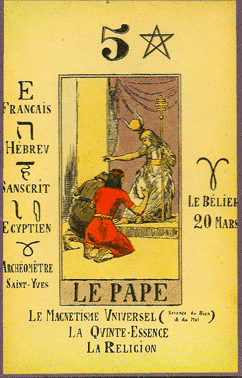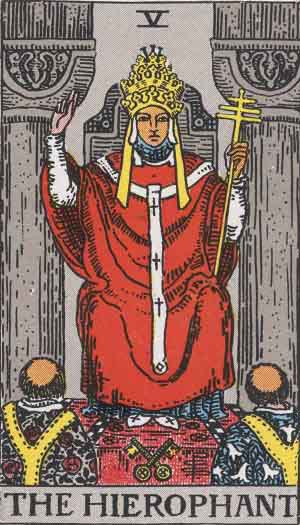Tarot Deep Dive - The Hierophant
- Dustin

- Nov 8, 2020
- 6 min read
Updated: Aug 14, 2021
In this series we are going to dive into the history of the imagery found in the tarot, the meaning of the card and how it changed over time, and the symbols present within what is arguably the most well known tarot deck of today - the Rider-Waite (Smith) Tarot Deck. So grab your favorite RWS deck, a cup of tea or coffee, and join me live on Sunday mornings over on YouTube as we Deep Dive into each one of the 21 Major Arcana cards continuing with the classical figure of the Hierophant.

Tarot as we know it today has it's origins rooted in Italy. Yes, we can trace it much further back to card games that came to Europe through the Middle East from Asia, but the modern decks we all know and love today can trace their heritage back to decks created during the renaissance in Italy and other parts of Europe. These are what we categorically lump under the term 'Marseilles'; a descriptor coined by the card Historian Romain Merlin to describe Tarot cards made in the Marseilles region of France and then made famous through occultists like Eliphas Levi in the mid 1800s. This term has grown today to really encompass any ancient style tarot from Europe from the 13th century forward, for the most part. Much of the structure of modern decks, especially those from the Golden Dawn lineage, are taken directly from these early decks. Given their place and time of development, these decks are full of Christian symbolism and iconography that we see carried forward into some of the most popular decks of today such as The Rider Tarot.
The context of history here is critical when discussing The Heirophant because while the Tarot was being made in Italy during the Renaissance, The Papacy was not just the head of the Roman Catholic Church as a religious institution. The Papacy was also a political and military force in Italy much like many other City-States. The Pope in Rome ruled not only over the city of Rome and the souls devoted to the Catholic faith, but the Papal states too. The Papal States included many of the lands and cities in central Italy as we can see in this antique map of Italy below, the Papal States are indicated in green.
The predominance of Catholicism in this time in Italy and in other areas of Europe led to the proliferation of Catholic themes we see in these ancient decks such as the Pope, The Pappess, Death as the Grim Reaper, and a card featuring the biblical scene of The Last Judgement.
Visual Evolution
The more commonly encountered modern name "Hierophant" is due to Antoine Court de Gébelin. According to Gébelin, "hierophant" was the title of the highest level priest in the ancient Greek tradition known as the Eleusinian Mysteries. The name of the card stays pretty standard throughout history, with very little variation other than language. This is with one exception (aside from the Golden Dawn... who loved a flair for the dramatic), some Marsielle decks replace the Pope card with Jupiter, as you seen in the now popular 1JJSwiss deck. Some think this was done to avoid upsetting the church and the Pope in power at the time. Other decks also refer to this card as the High Priest, a counterpart to the High Priestess, but usually still depict the card in its traditional fashion. Visually the Hierophant is one card that has seen very little change over the course of time. This card usually always depicts the Pope in his papal regalia enthroned and offering a sign of benediction or blessing with two supplicants at his feet kneeling before him. The only diversion from this is in Papus' deck where we see a similar scene but the Pope appears and Ancient Egyptian Priest still holding the papal cross.
Evolution of Meaning
De Mellet (1781): Jupiter. The Everlasting mounted on an Eagle
Levi (1855): The Hebrew Heh, the pope. Indication, demonstration, instruction, law, symbolism, philosophy, religion.
Mathers (1888): The Hierophant, or Pope. Mercy, beneficence, kindness, goodness.
Golden Dawn (1896): Magus of the eternal gods. Hierophant. Aspiration, power of the keys, the outward show of spiritual authority, the temporal power of official religion; on the evil side, sacerdotal tyranny and interference.
Waite (1910): The Heirophant. Marriage, alliance, servitude; by another account [Mathers] mercy and goodness; inspiration; the man to whom the inquirer has recourse.
Crowley (1944): It is impossible at the present time to explain this card thoroughly, for only the course of events can show how the new current of initiation will work out. It is the aeon of Horus, of the Child. Though the face of the Hierophant appears benignant and smiling, and the child himself seems glad with wanton innocence, it is hard to deny that in the expression of the initiator is something mysterious, even sinister. He seems to be enjoying a very secret joke at somebody's expense. There is a distinctly sadistic aspect to this card; not unnaturally, since it derives from the Legend of Pasiphae, the prototype of all the legends of Bull-gods. These still persist in such religions as Shaivism, and (after multiple degradations) in Christianity itself. The symbolism of the Wand is peculiar; the three interlaced rings which crown it may be taken as representative of the three Aeons of Isis, Osiris and Horus with their interlocking magical formulae. The upper ring is marked with scarlet for Horus; the two lower rings with green for Isis, and pale yellow for Osiris, respectively.
The Symbols
Papal Tiara (Yes, it is a Tiara, not a crown.)

Also known as the triregnum, this crown represents the three (tri) rulerships (regnum) of the pontiff: Supreme pastor, supreme teacher, and supreme priest. Some link it to the threefold authority of the "Supreme Pontiff: Universal Pastor (top), Universal Ecclesiastical Jurisdiction (middle) and Temporal Power (bottom)". Others interpret the three tiers as meaning "father of princes and kings, ruler of the world, vicar of Christ"
Papal Cross

Often confused with the Cross of Lorraine. The Papal cross represents the pontiffs highest position in the church and is analogous with the Archiepiscopal Cross, which is a two-barred cross and is used to signify an archbishop. The three crosses are often associated with the triple tau or though to have symbolism close to that of the Papal Tiara. The three bars of the Papal Cross is generally considered to be representative of the Trinity – the Father God, the son Jesus and the Holy Spirit. They are also believed to symbolize the realms that come under the Pope’s authority, namely the Church, the heaven and the world.
Crossed Keys

The keys of heaven given to St. Peter by Christ represents the Pope's power both in heaven and on earth. They represent the mastery of both the mundane and the spiritual.
Supplicants in Roses & Lillies

As in many other cards in the RWS, the lily and rose appear yet again representing love and purity on the two supplicants that kneel before the Pope to signify being beneath the Holy Father who is the bridge between God and man.
Pillars

Waite makes it clear that these pillars are "not those of the temple guarded by the High Priestess" and does not go much further than that leading some to think they are insignificant. Others however believe that they represent the pillars of Liberty and Law or Obedience and Disobedience.
Hand Gesture

A blessing of benediction. With two fingers raised to heaven and two down to earth this symbolizes the bridge the pontiff serves as between heaven and earth. Another representation of the idea of 'as above so below' we see represented in other cards such as The Magician.
As always, be sure to check out our live discussion on this very topic over on YouTube:
References:
Butler, B. Dictionary of the Tarot. New York: Schocken Books, 1986.
Chang, T. Susan. Tarot Correspondences: Ancient Secrets for Everyday Readers. Llewellyn Pulbications, 2018.
Crowley, Aleister (aleister Crowley). Book of Thoth - (Egyptian Tarot). Red Wheel/Weiser, 2017.
Dean, Liz. The Ultimate Guide to Tarot: a Beginners Guide to the Cards, Spreads, and Revealing the Mystery of the Tarot. Fair Winds Press, 2015.
Fiebig, Johannes, and Evelin Burger. The Ultimate Guide to the Rider Waite Tarot. Llewellyn, 2013.
Katz, Marcus. Secrets of the Waite-Smith Tarot: the True Story of the Worlds Most Popular Tarot: with Previously Unseen Photography & Text from Waite & Smith. Llewellyn Publications, 2015.
Waite, A. E. Pictorial Key to the Tarot. Dover Publications Inc, 2005.
Wen, Benebell. Holistic Tarot. North Atlantic Books, 2015.
Other Sources:














Comments